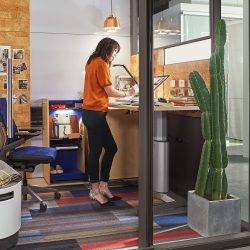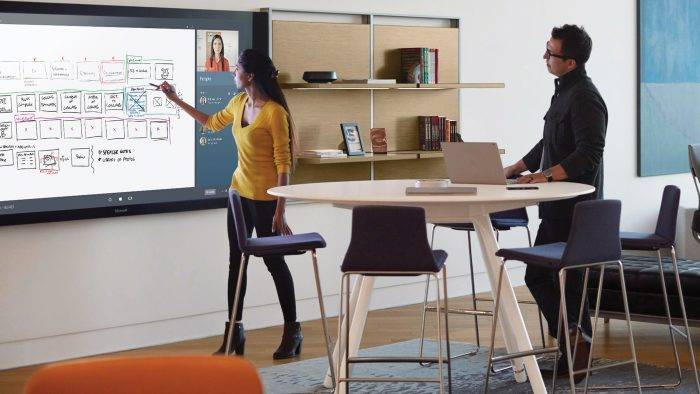 Today, the Fourth Industrial Revolution is changing the face of work as we know it: introducing AI and automation to the workplace and creating a drastic shift in the skills required by organisations today. As automation increasingly frees employees up from the repetitive, process work that can so often dominate their day-to-day, organisations are instead looking to employees to showcase their critical thinking and creativity. Indeed, McKinsey’s Skill Shift confirms that by 2030 the demand for higher cognitive skills, such as creativity, critical thinking and decision making will grow by 14 percent in Europe.
Today, the Fourth Industrial Revolution is changing the face of work as we know it: introducing AI and automation to the workplace and creating a drastic shift in the skills required by organisations today. As automation increasingly frees employees up from the repetitive, process work that can so often dominate their day-to-day, organisations are instead looking to employees to showcase their critical thinking and creativity. Indeed, McKinsey’s Skill Shift confirms that by 2030 the demand for higher cognitive skills, such as creativity, critical thinking and decision making will grow by 14 percent in Europe.
Mobile working is a critical way to foster such skills within the workforce. And it’s imperative that businesses move away from thinking of mobile working as a benefit, but instead make it part and parcel of our working lives. Nowadays, mobile technology and remote working can actually be the driver behind people’s creativity, productivity and efficiency – all of which are critical for business success.
Naturally, where we spend our working days has an impact on our ability to perform and be creative, no matter the task. As our research shows, an uninspiring workplace is seen by 2 in 5 employees as a barrier to creative thinking – and getting people out of the office can facilitate creative thinking by giving the brain new stimuli. This type of initiative is also something that employees find useful, with 25% saying that a work environment that offers a mix of spaces to foster collaboration, socialisation and focused work would boost creativity.

Steelcase / Microsoft (and main image)
Technology plays an important role in making this a reality. Mobile devices that are easy to carry anywhere provide us with the foundation for constant connectivity, tapping into our creativity wherever it sparks. They also help us take back control of our time and our work in way that best suits our individual needs. This might mean leaving work earlier to meet our childcare commitments and working later in the evening instead; or making that doctor’s appointment that we’ve been putting off because we never seem to find the time to schedule; or even skipping that busy commute and being more productive first thing.
Whatever the reason, mobile working gives us the chance to navigate the challenges of a busy life in a way that works for us and works for our work, too.
To seamlessly transition from working inside the office to working outside of it, cloud-based software is also key. It removes the need for insecure file sharing and enables workers to collaborate on documents in real-time, boosting both productivity and collaboration. Indeed, with collaborative technology at our fingertips, teams can be constantly connected, regardless of physical location – with video and instant messaging always available to make meetings feel more human.
The death of the office?
But this doesn’t mark the end of the office space. On the contrary, the office is still very much at the centre of our working lives. It just needs reimagining to make sure it remains relevant and fits with new ways of working – for example, with a variety of spaces that allow employees to think alone or work collaboratively as they need.
While change may seem daunting for many organisations, rethinking your workplace to ensure employees can be more productive and creative doesn’t have to be a major undertaking. To help create a workplace that employees want to be a part of, businesses can take some simple steps to boost workplace creativity and productivity:
1. Be vocal about why creativity is important to you as a business and be committed to helping your employees hone their creative skills
2. Help employees build creativity in within their daily activity, and offer coaching, training and daily exercises that will allow them to develop strong creative thinking skills
3. Give employees choice and control over how and where they work, offering a mixture of quiet and collaborative spaces
4. Ensure employees can get out of the office and work from different locations to boost energy levels and stimulate their minds
5. Empower employees with modern devices and technology that allows them to collaborate better with colleagues and capture their thoughts on the go
There is no doubt that we have come a long way from the closed-off cubicles of the past. But, as technology is in constant evolution, so is the way we work. And the major change that needs to happen now is for mobile and remote working to become commonplace. Not only because it helps employees navigate their personal and professional lives in ways that work for them, but also because it encourages the out of the box thinking that successful businesses are built on.
___________________________________________
Sally Elliott is Surface Strategy Lead at Microsoft UK














March 14, 2019
Mobile working is a recipe for business success
by Sally Elliott • Comment, Technology, Workplace design
Mobile working is a critical way to foster such skills within the workforce. And it’s imperative that businesses move away from thinking of mobile working as a benefit, but instead make it part and parcel of our working lives. Nowadays, mobile technology and remote working can actually be the driver behind people’s creativity, productivity and efficiency – all of which are critical for business success.
Naturally, where we spend our working days has an impact on our ability to perform and be creative, no matter the task. As our research shows, an uninspiring workplace is seen by 2 in 5 employees as a barrier to creative thinking – and getting people out of the office can facilitate creative thinking by giving the brain new stimuli. This type of initiative is also something that employees find useful, with 25% saying that a work environment that offers a mix of spaces to foster collaboration, socialisation and focused work would boost creativity.
Steelcase / Microsoft (and main image)
Technology plays an important role in making this a reality. Mobile devices that are easy to carry anywhere provide us with the foundation for constant connectivity, tapping into our creativity wherever it sparks. They also help us take back control of our time and our work in way that best suits our individual needs. This might mean leaving work earlier to meet our childcare commitments and working later in the evening instead; or making that doctor’s appointment that we’ve been putting off because we never seem to find the time to schedule; or even skipping that busy commute and being more productive first thing.
Whatever the reason, mobile working gives us the chance to navigate the challenges of a busy life in a way that works for us and works for our work, too.
To seamlessly transition from working inside the office to working outside of it, cloud-based software is also key. It removes the need for insecure file sharing and enables workers to collaborate on documents in real-time, boosting both productivity and collaboration. Indeed, with collaborative technology at our fingertips, teams can be constantly connected, regardless of physical location – with video and instant messaging always available to make meetings feel more human.
The death of the office?
But this doesn’t mark the end of the office space. On the contrary, the office is still very much at the centre of our working lives. It just needs reimagining to make sure it remains relevant and fits with new ways of working – for example, with a variety of spaces that allow employees to think alone or work collaboratively as they need.
While change may seem daunting for many organisations, rethinking your workplace to ensure employees can be more productive and creative doesn’t have to be a major undertaking. To help create a workplace that employees want to be a part of, businesses can take some simple steps to boost workplace creativity and productivity:
1. Be vocal about why creativity is important to you as a business and be committed to helping your employees hone their creative skills
2. Help employees build creativity in within their daily activity, and offer coaching, training and daily exercises that will allow them to develop strong creative thinking skills
3. Give employees choice and control over how and where they work, offering a mixture of quiet and collaborative spaces
4. Ensure employees can get out of the office and work from different locations to boost energy levels and stimulate their minds
5. Empower employees with modern devices and technology that allows them to collaborate better with colleagues and capture their thoughts on the go
There is no doubt that we have come a long way from the closed-off cubicles of the past. But, as technology is in constant evolution, so is the way we work. And the major change that needs to happen now is for mobile and remote working to become commonplace. Not only because it helps employees navigate their personal and professional lives in ways that work for them, but also because it encourages the out of the box thinking that successful businesses are built on.
___________________________________________
Sally Elliott is Surface Strategy Lead at Microsoft UK